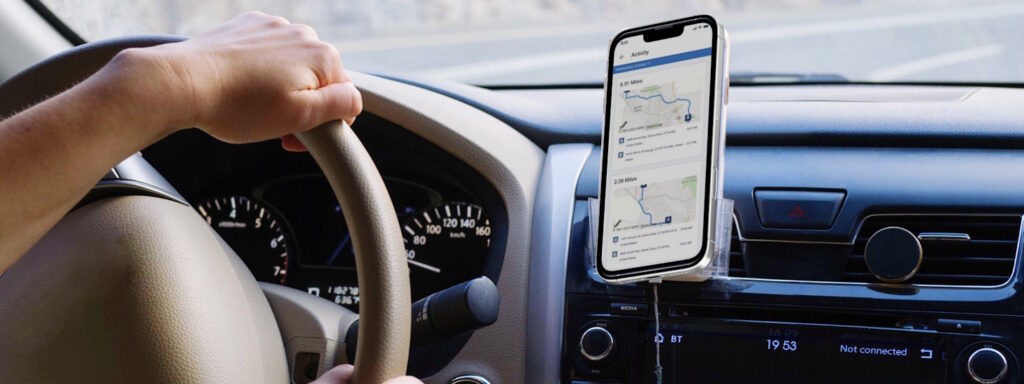
Exploring whether smartphones are a viable alternative to On Board Units for GNSS tolling.
29 August 2025
For more than 20 years, Europe has been operating nationwide Multi-Lane Free Flow (MLFF) tolling systems to levy distance-based charges on trucks. Initially, these truck tolling systems deployed either a microwave-based or a satellite-based solution. In 2025, nine nationwide truck tolling systems in Central and Western Europe are based on satellite technology while Austria and Slovenia still operate systems using the microwave approach, based on Dedicated Short-Range Communications (DSRC). The preference for using Global Navigation Satellite System (GNSS) for national tolling schemes is overwhelming, as this technology has proven to be highly cost-effective and extremely flexible. With GNSS, there is no need to build gantries on each individual section of the tolled road network as required by a “tag and beacon” system that requires DSRC or RFID readers at each tolling point. In fact, when the Czech Republic replaced its DSRC tolling technology with GNSS in 2019, it removed more than 100 gantries equipped with costly microwave equipment, cutting operation expenses in half while doubling the tolled road network – and thus increasing the overall toll revenue.
Poland Introduces Smartphone Tolling in 2021
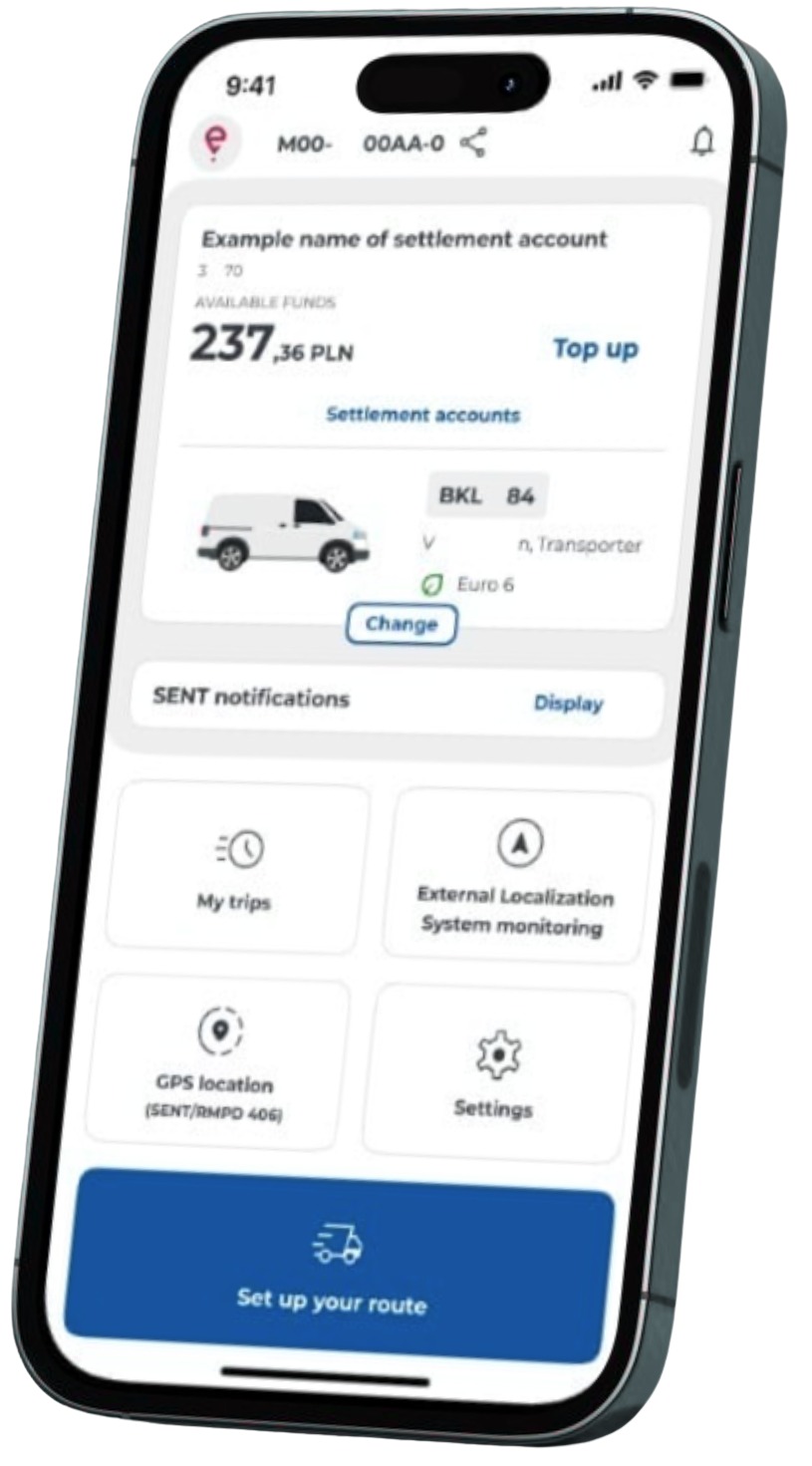
When Poland replaced its DSRC-based truck tolling system in 2021 with the new satellite-based e-Toll System, it introduced a smartphone app as an option for road users to make automated toll declarations while driving on the tolled road network. The smartphone solution is offered as a free alternative to On Board Units (OBUs) which are provided by a qualified OBU operator. Toll Service Providers that provide a GNSS-based OBU or tracking device charge a subscription fee for making toll declarations, and invoice the users for the distance-based fees charged for each trip on the tolled roads.
The Polish agency responsible for the operation of the e-Toll system, the Department of Road Toll Collection at the Ministry of Finance has published statistics about the various options for toll declarations on the tolled road network, having a length of approximately 5220 km, as summarized below.
Percentage of Toll Transactions in Poland by Different Type of Devices in Q2 2025

All Trucks and Buses
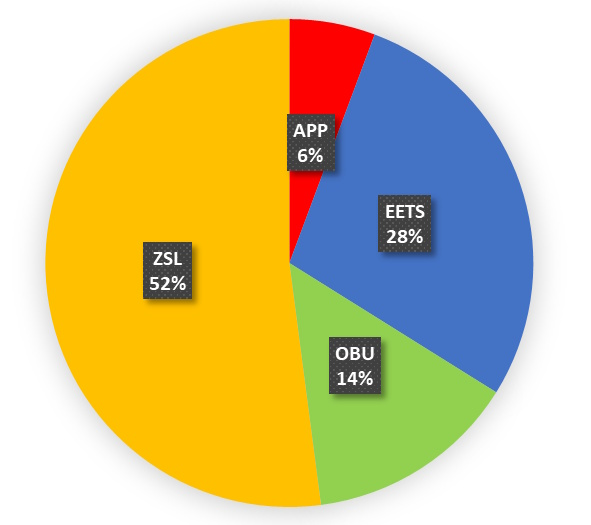
387.5M total transactions
No. of Device Registrations for Polish Trucks > 12t
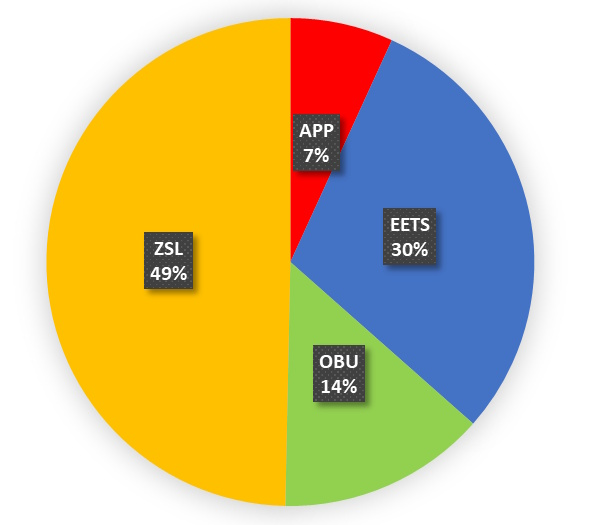
349.1K registered vehicles
No. of Device Registrations for Polish Trucks > 3.5t and < 12t

74.6K registered vehicles
Graphic © GNSS Consulting
The diagrams above illustrate that in the second quarter of 2025, 6% of all the trucks and buses – national and international – processed their toll transactions using the free smartphone app while driving on the tolled road network in Poland. A majority (52%) of all toll transactions were made using a tracking device operating within Poland, supplied by service providers known as “External Location System” (ZSL = Zewnętrzny System Lokalizacyjny in Polish). Another 28% of the transactions were made with a tolling OBU made available by a provider of the European Electronic Toll Service (EETS), while 14% of the vehicles used the service of a provider that supplies a windshield-mounted OBU that only works within Poland. The second pie chart shows that the actual percentage of device registrations for the Polish-registered trucks above 12t, by far the largest category using the e-Toll system, is very much in line with the overall percentage of the actual transactions. The third pie chart illustrates that among the smaller commercial trucks in Poland, between 3.5t and 12t, the smartphone app was clearly the most popular choice, covering 46% of all device registrations in this group of vehicles. Even though this is a relatively small percentage of the total amount of truck traffic, it demonstrates the potential of the smartphone for specific segments of the vehicles using the tolled road network – such as small local businesses making deliveries within the country.
Denmark Launches Truck Tolling with a Smartphone App in 2025
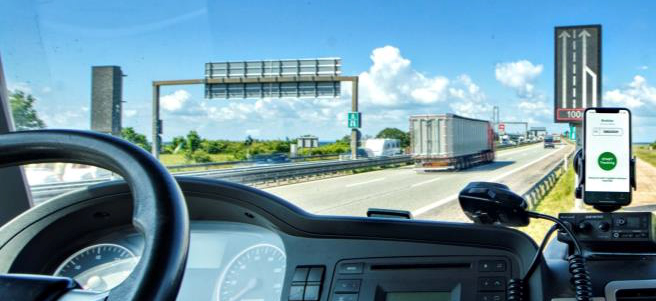
In 2025, Denmark became the second country to introduce a smartphone app for a nationwide truck tolling system. The “KmToll” (in Danish Vejafgifter) covers a tolled road network of Danish state road network and parts of the Danish municipal road network, about 10,900 km in length, and applying to trucks above 12t.
The Danish truck tolling system is the first such system in Europe that does not have a national “main service provider” but relies on the use of EETS OBUs, with an app and a ticketing system for individual trips as alternatives. Since one of the EETS providers, Brobizz, is 100% state-owned, the risk of the state-owned toll operator Sund & Bælt having to rely on the “good will” of an EETS operator providing enough OBUs to meet the demand in Denmark could be easily mitigated. In fact, the take-up of EETS OBUs was higher than originally anticipated.
Percentage of Distance Driven by Toll Declaration Type in Denmark in 2025 (January-July)
Graphics courtesy of Sund & Bælt Holding A/S
Graphic © GNSS Consulting
The graphics above show that during the period between the beginning of January to the end of July in 2025, the first seven months that the KmToll system has been in operation, a total of 1139.3 million kilometers were driven on the tolled road network by trucks above 12t. The statistics provided by the operator reveal that this total figure can be broken down into 1068.9m vehicles using toll declaration equipment (OBU or smartphone app), and 70.4m using the ticketing system whereby each complete trip is paid for without using any electronic device in the vehicle. While the EETS OBUs make up for 93% of all toll declarations, the smartphone app has been used for only 1% of the declarations.
Why Is There a Low Demand for Smartphones Apps in Truck Tolling ?

Truck forwarding companies have a fleet of vehicles, and a staff of truck drivers who drive those vehicles. Clearly, it is more convenient to have a dedicated device installed in each vehicle than having each truck driver install an app and declare that their smartphone is associated with the specific vehicle that they are currently using. It is also likely that truck drivers would prefer to keep their own smartphones for private use, thus requiring the trucking company to provide the driver with a company smartphone, which would cost more than an OBU. There is also a risk that a truck driver may forget to activate or deactivate the smartphone app when starting or ending a trip. Not having an active OBU or correctly registered app while using the tolled road network can result in high penalties that could quickly exceed the cost of a dedicated OBU. As described in further detail below, there may be other issues with smartphones such as poor position accuracy, depending on the model of the phone and where it is located inside the vehicle.
Can Smartphones Replace On Board Units for Satellite Tolling?
Since virtually all road users in Europe – and other parts of the world – own a smartphone, each being equipped with a GNSS receiver, it would seem logical to use the geo-positioning functionality of those smartphones rather than having to manufacture, distribute and install dedicated GNSS devices. In recent years, GNSS-based tolling OBUs in Europe have had a price tag of about €100 ($115) for road operators and for EETS providers. In mid-2025, Denmark had approximately 8,000 registered smartphone apps in use for the KmToll, and Poland had around 76,000 registered smartphone users for the e-Toll system. In both cases, the reduction in the number of needed OBUs due to the use of smartphones was not that significant. However, if a new tolling system needed to invest in the supply of millions of dedicated OBUs, the initial cost would be quite substantial.

This was the case in Indonesia, where a new GNSS-based solution was developed to replace the existing toll plazas on the national highway network, requiring about 50 million (!) users to be equipped with a GNSS device. In 2021, the Indonesian government awarded a contract to a Hungarian consortium to build a satellite-based solution on the entire tolled motorway network of 2,578 km, which should be extended to a total of approximately 6,000 km over the course of nine years. This groundbreaking project would replace “stop and go” tolling at toll plazas with a new Multi-Lane Free Flow system based on GNSS. Unfortunately, the project has faced delays due to challenges with the underlying business model – but not the technology. Consequently, there is no data available for the actual operation of such a novel tolling system. A new toll system in which tens of millions of drivers would use a smartphone app to automatically identify when a toll road section was driven on, to charge the distance travelled on the toll roads, would surely face many challenges. On the other hand, if GNSS OBUs would cost just $50 each, the total amount needed to supply 50 million users with OBUs would reach $2.5 billion![3]
Advantages of Using Dedicated GNSS OBUs

With the advent of EETS and the growing number of Toll Service Providers (TSPs) offering tolling OBUs that can be used in multiple countries, the use of smartphone apps are not overly attractive, as the statistics from Poland and Denmark have shown. Truck forwarding companies clearly prefer an EETS solution, especially since a single service provider can be chosen that takes care of all registration and payment issues in multiple European countries. Smartphone apps, on the other hand, are only made available for a specific toll domain – as is the case with Poland and Denmark, with Lithuania most likely to follow.
EETS accreditation is a lengthy and costly process, requiring at least six months of testing and detailed approval procedures defined by the Toll Charger of the specific toll domain. During this process, the hardware and software solutions of the EETS providers are thoroughly tested. TSPs typically apply for a single OBU configuration to get accreditation. With a smartphone app, there is not a specific hardware, since theoretically any available smartphone can be used. Whereas GNSS OBUs are designed and manufactured with the requirements of the toll domains in mind, smartphone manufacturers are oblivious to the specific needs of tolling systems.
GNSS OBUs also meet strict automotive requirements, such as high levels of vibration and the ability to withstand very high and very low temperatures. Tolling OBUs are specially designed to accurately record and transmit the travel data needed to determine the exact payment required from vehicles travelling on a tolled road network. These OBUs securely store and send data packages of the needed trip information to a tolling back office, and are usually tamper-proof. Road users cannot simply turn off an OBU or open the casing to remove the OBU’s SIM card or the back-up battery to prevent trip data from being submitted to the tolling back office, where the distance-based are calculated and invoiced.
Automation is the Key for Cost-Effective Tolling System Operation
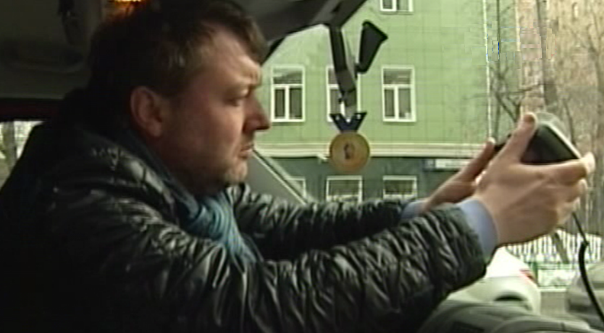
A main advantage of dedicated GNSS OBUs is the simple installation and handling: “plug and play.” An OBU is first initialized with the vehicle data, typically by the toll operator (e.g. at a point of sale) or by an EETS provider. The OBU is then placed on the windshield of the vehicle, with a power connection, so that the truck driver (and the trucking company) is not otherwise involved in the process of collecting the toll data. Once the installation is completed, there is no need for any road user intervention – unless a change of vehicle category is needed (when a trailer is attached) or in case there is a failure of the OBU hardware, in which case the driver is usually notified by an auditable alarm and a red warning light on the OBU. The more automated the entire process is, the more cost-effective the overall toll operations will be.
[3] These costs would most likely be carried by the road users who would need to purchase a subscription from a service provider, similar to the EETS approach in Europe
The Challenges of Smartphones for Satellite Tolling
In contrast to the advantages of special-purpose tolling OBUs cited above, smartphone apps face significant challenges. First and foremost is the required involvement of the road users who need to properly download the app, correctly register their vehicle, and activate the app before driving on a toll road. Users of the app need to make sure that their smartphone has enough power for the entire duration of the trip, and that enough memory is available on the device to store the travel data when there is no cell coverage or poor data connectivity along the travelled route. Smartphone users also need to make sure that their service package has a sufficient data package for all the travel data to be transferred to the back office. Users must also be wary of fraudulent apps that pretend to be the actual tolling app, with toll charges going to an illegal entity until the fraud is eventually identified.
Position Accuracy is Essential for Satellite Tolling

The position accuracy of a smartphone is particularly vital to the correct calculation of distance-based fees. Since there is a great variety of GNSS receivers among the many smartphones on the market, discrepancies in accuracy of the geo-positioning used by different phone models are inevitable. Even with a very accurate GNSS receiver in the smartphone, position accuracy can be greatly diminished if the smartphone is not placed near the front windshield. When a smartphone is tucked away in a driver’s pocket, bag, or somewhere in the back seat, poor position accuracy will be the result– and the connection to the cellular network could be impaired as well. If a smartphone’s connectivity is diminished, toll declarations may not be declared within the required timeframe.
The Potential for Smartphones in Satellite Tolling
With the experience of truck tolling systems in Poland and Denmark, there is clear evidence that smartphone apps can be a viable option for automated toll declaration in a large tolling scheme. The acceptance of the smartphone option has been limited so far. In any case, experienced truck drivers can use a smartphone app reliably for toll declarations when provided with clear instructions and a user interface that is intuitive and easy to use. However, as described above, the road users bear a significant burden when using a smartphone app for tolling. They are solely responsible for making sure that their smartphones are operating correctly, placed in a correct position, and have sufficient battery power for the duration of their trip. There are many variables involved, and the chances of something going wrong with the collection of correct and accurate trip data is relatively high – especially when compared to a dedicated tolling OBU that can work reliably without the direct involvement of the driver.
Smartphones apps may find a suitable place in the mix of tolling “hardware” in the years to come, but at this early stage it is difficult to predict the future of smartphones in distance-based road pricing. Only time will tell whether the smartphone alternative to tolling OBUs can result in significant savings in the long run. While the initial investment in dedicated OBUs can be potentially reduced – and perhaps eliminated altogether – the overall operational costs of a national tolling scheme could increase significantly when a high degree of user interaction is required, thus diminishing the level of automation in the overall tolling process. The costs of staffing and operating a large call center alone would likely offset any initial reduction in the investment costs of providing dedicated tolling OBUs.
The evolution of Multi-Lane Free Flow tolling over the past 20 years has been substantial. Within the next 20 years, electronic tolling could change even more quickly. Today, we can already imagine using multiple sources of geo-positioning data in the vehicle for the purpose of road pricing. Virtually all new cars are equipped with GNSS receivers that could provide a secure and accurate source of travel data to determine the distance travelled on a tolled road network – or on any type of road. With the rise of electric vehicles in the market, it seems inevitable that distance-based charging of all vehicles will be needed as fuel tax revenues steadily decline. It may only be a matter of time before the use of geo-positioning becomes the standard for financing road infrastructure, and requiring the transmission of travel data from all vehicles on public roads becomes common practice.
[1] Switzerland (2001), Germany (2005), Slovakia (2010), Hungary (2013), Belgium (2016), Czech Republic (2019), Bulgaria (2020), Poland (2021), Denmark (2025).
[2] Statistics available for the first quarter of 2025 had very similar figures.
[3] These costs would most likely be carried by the road users who would need to purchase a subscription from a service provider, similar to the EETS approach in Europe.